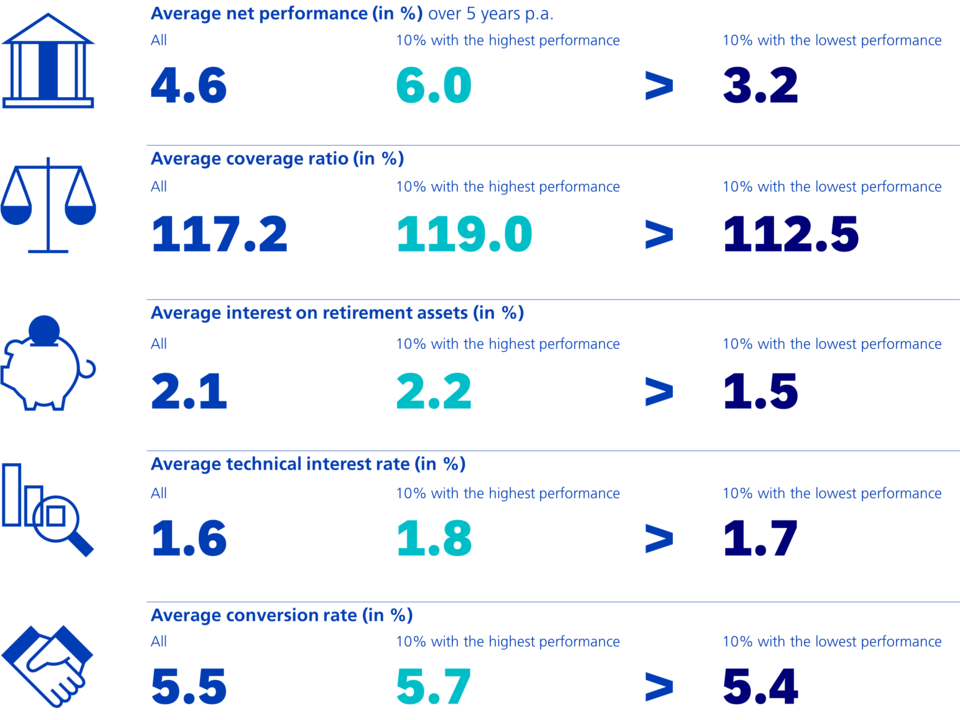Pension funds in Switzerland: Stronger, larger and with potential for more returns
Three striking trends can be seen in the pension fund landscape. Firstly, the financial condition of the institutions has improved significantly. Secondly, large pension funds are increasingly driving out smaller ones. And thirdly, the difference in returns between the funds is considerable.
Text: Heini Dändliker, Iwan Deplazes

Good returns make Swiss pension funds fitter
Good returns on the capital markets are a boon. They confirm the importance of successful asset management in the pension system, enable pension funds to build up reserves and have a positive effect on the coverage ratio. The average coverage ratio of pension funds even climbed to record levels in 2020, as the Swiss Pension Funds Study by Swisscanto Pensions Ltd. shows. For the first time since the start of the study, the threshold of 115 percent has been exceeded for private-sector funds. This provides a safety cushion to hedge an average equity portfolio and other price risks.
Significantly larger value fluctuation reserves
Value fluctuation reserves have also increased enormously. 69 percent of all pension funds increased their target value fluctuation reserves to at least 75 percent. For comparison: in 2018, the figure was 27 percent, and in 2019 it was 63 percent. Pension funds from private employers (PA) accounted for the highest value fluctuation reserve at 78 percent of the target value, compared with 72 percent in the previous year. For public employers' pension funds (OA), the figure is 40 percent, after 29 and 6 percent in 2019 and 2018 respectively. With the greatly improved financial basis, more free funds are available to active insurance members. This is a welcome development given the redistributions in recent years.
Large difference in returns across pension funds
Generating good returns makes it possible to maintain the level of benefits of the pension funds and reduce the subsidisation of pensioners by the younger generations. However, there are large differences in returns between pension funds, as the Pension Funds Study further illustrates. In 2020, the gap ranged from –6.5 percent for the worst to +12.3 percent for the best fund. The spread was also similar in previous years. On average over the last five years, the return difference between the top 10 percent and the bottom 10 percent per year is almost 3 percentage points, or cumulatively around 15 percentage points. The study also notes that the differences in returns do not arise due to a structurally lower risk capacity.
Comparison of pension funds with the highest vs. the lowest performance

The larger the pension fund, the greater the ESG share
There is a correlation between the size of the total assets of a pension fund and investments that apply sustainability strategies in the form of ESG criteria (Environment, Social, Governance). Accordingly, the relative ESG share increases with the total assets of the pension funds. For comparison: pension funds with total assets of less than CHF 50 million have an ESG share of 14.8 percent, while pension funds with total assets of more than CHF 5 billion have an ESG share of 56.2 percent.
Investments according to ESG criteria relative to fund size
| Fund size (total assets, CHF) | Investments according to ESG criteria |
|---|---|
| <50 Mio. | 14,80% |
| 50-100 Mio. | 22,50% |
| 100-500 Mio. | 27,50% |
| 500-1'000 Mio. | 29,10% |
| 1'000-5'000 Mio. | 39,60% |
| >5'000 Mio. | 56,20% |
Source: Swiss Pension Funds Study 2021, Swisscanto Vorsorge AG
Large pension funds appear to have recognised the necessary developments in the area of sustainability at an earlier stage and are therefore better positioned with regard to expected regulatory changes for sustainable investment management.
Smaller pension funds continue to be driven out
The development of recent years is clear: large pension funds are increasingly squeezing out smaller funds. According to the Federal Government's pension fund statistics (as of 2019), collective and joint institutions now manage almost 50 percent of the total assets of all Swiss pension schemes of more than CHF 1,000 billion.
Overall, the number of pension schemes has decreased from 3,416 to 1,491 since 2000. This loss occurred primarily with institutions with total assets of less than CHF 100 million.
The backlog of reforms in occupational pensions combined with demographic trends, the ever-increasing demands on capital market expertise and the increasing regulation make business more difficult for smaller pension funds – a trend that is likely to continue in the future.
